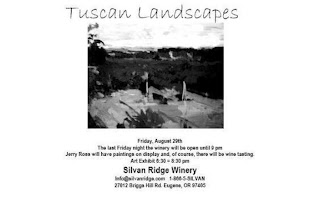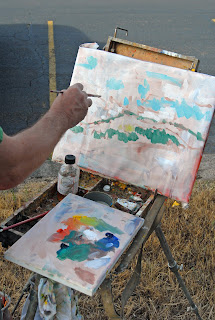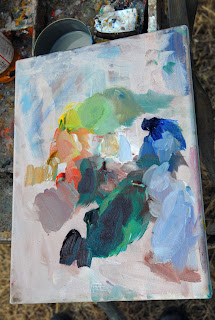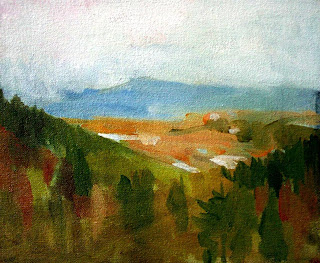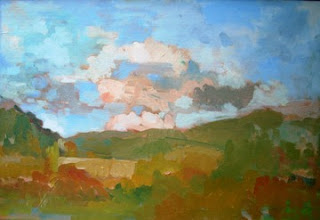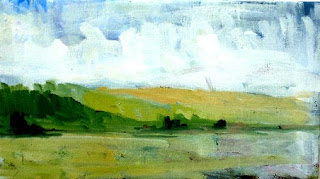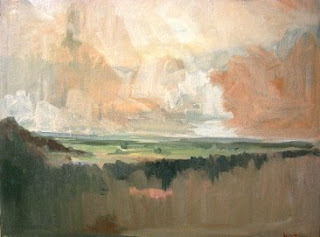We will meet at LCC near welding shop one more time:

In case of heavy rain head for Maude Kerns.
Firstly, to review color poolo mixing concept:

The exact placement of the colors making up the color pool does not matter that much. In this picture you can see I have switched the location of yellow and red.
The idea is to have two separate mixes of complements (warm yellow and cool blue, on he one hand, and warm red and cool viridian on the other end). If you switch locations of red and yellow then the mixes are different (warm red and cool blue, on the one end, and warm yellow and cool virdian on the other). In any case, you get a lot of neutrals in the mix of complements, especially when you add white.
Note that the pool is dominated by the two different complement mixes. Each os the mixes creates a set of neitral tones that can be made warmer or cooler by addition/subtraction of an appropriate amount of the complement involoved in the mix.
New Topic: Gesture and Perspective in Landscape Painting
In order to create an interesting landscape painting in plein air, it is important to capture the gesture and perspective of a scene quickly. By "gesture" I mean the same thing as when painting from the nude when we capture the gesture of the body in a few strokes. Landscape also has its gestural movement which can be captured by paying attention to main diaglonals, horizontal, and vertical lines:

Note: eye movement and gesture are created at the very start when a very simplified drawing is created. In this initial sketch we are still looking for "effect" or the dramatic (dal vero) impact of nature as well as your feeling and your own sense of empathy for and with the scene:

Note: look at the diagonal movement indicated by the arrows. One must keep an awareness of the overall slope and movement of the scene by discovering the main pivot lines, horizontals and verticals and sweeping diagonals which aid in recreating the energy and power of the scene.

When sketching like this, deliberately exaggerate and emphasize the dramatic elements, especially shapes of the cloud masses that give the scene movement. Even on a cloudless sky I sometimes introduce clouds that are not there for this purpose:

After we study and discuss these preliminary sketches we shall look at painting examples along the same lines. Your success as a plein air painter will depend on your ability to capture the gesture and movement (energy) of the scene.

Example in painting:
Here is how I approach creating a Tuscan landscape with eye movement and gesture in mind:

Note the diagonal created with paint -- the brush comes right out of the color pool mix and does not have a single color on it. Notice the "point/counter-point" with the two opposing diagonals that play with one another and give the painting tension:

This diagonal is strengthened by adding some dark green accents:





Starting a painting of the Tuscan town Cetona, with gesture:



Assignment for thursday: When you arrive on the scene please try to begin with gesture painting without preliminary drawing this time. Paint wet in wet and try to discover the scene through gesture and movement. Look for strong diagonals, verticals, and horizontal formations. Piant with as big a brush as you can and avoid any details until later. Establish your color pool first.




























